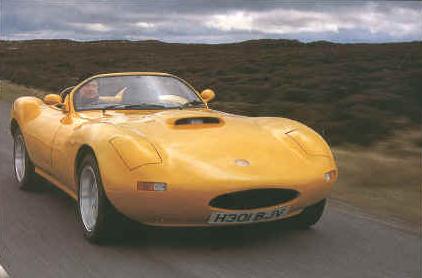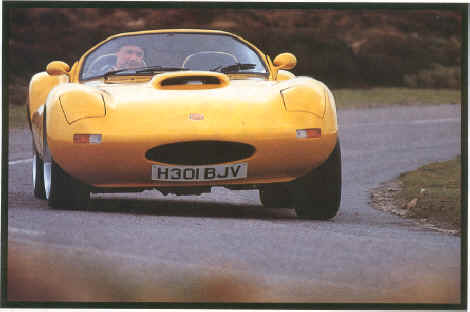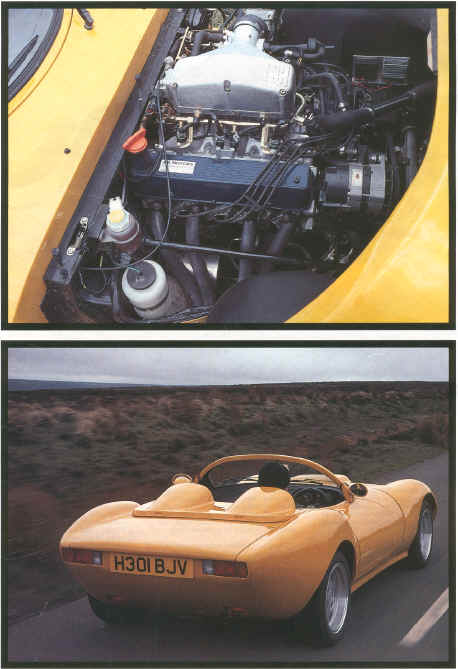Car July 1991
A STREAK OF COLOUR AND A WUFFLING bellow scythe through the grey dampness of a May day on the Yorkshire Dales. The colour, a strident yellow, belongs to the new Ginetta G33 glass fibre-bodied roadster, the noise to the 3.5-litre Rover V8 nestling beneath its bonnet. This particular car is a prototype, and, as yet, there's no hood for it, not even a tonneau. Rain, pushed side wards off the windscreen by the wipers, trickles its way around the A-pillars, and flies towards the driver. There are no side windows, nor will there be, so when the wind's blowing perpendicular to the direction of travel, rain assaults the cabin from all directions. Water leaking in from who knows where collects inside the Ford-sourced steering column, then deposits itself on my left leg through right-hand corners. The heater works, but there's only one fan speed and, in this car, no way of directing the flow. Spray is slowly turning the inside of the windscreen translucent, and my gloved hand merely smears it into an impenetrable mess. The leather-swaddled driver's seat has insufficient padding (to be fixed for production examples), so my bum's numb. And because the G33's been built in a bit of a hurry to get it on the road for us, there are innumerable irritating squeaks and rattles. By all rights it should be a miserable day; I should be feeling down and dejected, my spirits as damp as my trousers. But my spirits are glowing, my smile beaming. The weather is a wash-out, but water can't dilute the fun: this car is providing first-rate entertainment.

Blip the throttle and a hard edged crackle cracks the surrounding air asunder.
Major G33 plus-points are the way it goes and the way it sounds. Both come courtesy of the darling of small-volume manufacturers, the Rover V8. Production versions of the G33 will have the standard 3.9-litre lifted straight from the Range Rover, but the development car Pm driving has the old 3.5-litre, fitted with the 3.9's injection system. Ginetta has yet to dyno-test the 3.9-litre, but for now is quoting the same outputs as for the Range Rover - 185bhp at 4750rpm, and 2351b ft of torque at 2600rpm. The horsepower figure, at least, will change once the final production version of the car has been through its paces on the rolling road - the 3.5-litre has been tested at 202bhp. The power increase can be attributed to the exhaust system, which Ginetta fabricates from the manifolds back to the feeble-looking tailpipes (rather more butch oval pipes are on the way). The exhaust manifolds are worth lifting the one-piece front end for, as the nearside front pipe has an amazing right-angle kink. Perhaps that kink has something to do with the magnificent, air-filling, ground- rumbling, spine-tingling sound that spills through the car from the engine's first revolution. Whatever causes it should be patented. All Rover-powered cars make a great noise, but the G33 surpasses them all, even the burbling TVR, for raw, animalistic appeal. It's an array of noises, more racer than road car. Blip the throttle a few times and a hard-edged, pit-lane cackle cracks the surrounding air asunder. It settles down to a slightly uneven, burbling idle, but still sounds loud and vaguely menacing. At tick over you can tell you're in for a good time, just by listening. You can feel it, too, as the car rocks ever so gently, side to side, marking time to the engine's detonations. First gear isn't necessary to pull away. Try second or third, it makes little difference. There's enough torque to tow a battleship - and this is the 'small' engine. Gear changing is something you do only if you can be bothered, or you're in a real hurry. Fifth is just fine for most town driving, fourth if you're baulked. As the revs rise -and if you're not paying attention, they'll do so with surprising rapidity - the engine note changes from grumbling badness, to wicked yowling. At 1500.rpm, it emits a deep, booming resonance, which bangs out a percussion of pain on your eardrums. By the time the tacho needle is bearing down on the 6400rpm mark (where you have to pretend there's red paint), the demonic wailing has transported your imagination to some American raceway.


And it's not just bluster. The G33 has big league performance, the sort that smashes you back into the seat with startling violence, and chirps the tyres as you snatch second and third. Whenever you need it, there's plenty of muscle - no waiting around for a turbo to hit boost, no drumming your fingers while a 16-valver works its way up to the peak of its power curve. Throttle response is instant, and usually brutal. As the old saying goes, there's no substitute for cubic inches. Especially when they're sitting in a lightweight body. The G33 weighs a skimpy 14541b, and even using a pessimistic 200bhp power figure, that equates to 308bhp per ton. Grunt galore. Ginetta hasn't conducted any formal performance testing, but has run this yellow prototype up to 150mph, using the tachometer and gear ratios to gauge the speed. A speculated low 5.0sec 0-60 time seems entirely feasible, but, when proper testing is carried out, the fourth-gear acceleration times will impress most. A Porsche-eater from a company you probably know little about, if you've heard of it at all ? Implausible though it sounds, the concept slots neatly into Ginetta's history. Back in the mid-'60s, the company's G12, a mid-engined sports racer, was competing successfully on the track, against cars such as the AC Cobra.


Racing is where Ginetta started. Founders were the four Walklett brothers - Douglas, Trevers, Bob, and Ivor - who in 1958 started a construction engineering business. Motorsport was, at first, just a distraction, the brothers campaigning cars largely designed and engineered by Ivor. But by the time their fourth car was ready to roll, it was decided to turn a hobby into an enterprise. Although subsequent Ginettas have been designed for road or track, most look more at home with a roll cage and numbers than they do with metallic paint and alloys. An exception is Ginetta's latest car, the mid-engined (1.6i and 1.9i) G32, the Scunthorpe company's interpretation of the X1 /9, and its attempt to break into the 'serious' car market. It's fully trimmed, well equipped, and, most important, type-approved. The G33 is also to be; type-approved, but it's much closer in spirit to the earlier, track-inspired cars than to the G32. (Two of the older cars, the G4 and G 12, are re-manufactured, using original moulds, to satisfy the desires of Far Eastern markets.) It's not intended as an everyday car, so there are precious few concessions to practicality or luxury. It's a sunny weekend toy for the rich or the enthusiast. Yes, the undernourished seats of the prototype are leather-covered, and there's a fancy steering wheel and a stereo, but that's your lot. Anything else adds unwanted weight. Cheap, matt-black vinyl, the sort which swathed many an early Midget interior, wraps everything from the plain-Jane fascia, to the wide, hard-to- straddle door sills. The door trim panels are rudimentary, and follow closely the line of the featherweight door, as it curves out a long way from your right elbow. The doors are opened by a lever in the sill from the inside, by a button on the rear wing from without.


The driving position in the prototype is under review. Currently the steering wheel is too low, and the seat too high, a combination which obscures the top of the instruments, and threatens to chafe the top of your thighs. To cure the problem, Ginetta is going to carve a dip in the glassfibre floor pan, so the seat will. be lower.' suspect this will create other problems, because even in the development car you sit with your nose at the height of a bicycle saddle. As it is, the top of the doors are almost at shoulder level, the view out the small windscreen reduced by the triple humps of wings and power bulge. It's the steering column needs altering, not the seats. But as Ginetta is keen to point out, there's a lot of development still to go, and it's a small enough outfit (60 staff, building five cars a week) to effect changes quickly. And the way the G33's designed -tubular galvanised steel backbone chassis, glassfibre body- means it's possible to make quite major changes, relatively easily. Since the car was first shown at the NEC last October, for instance, the cockpit space has been increased, the rake of the screen decreased, and a new facia molding installed.
Even in the few weeks since I drove it, there have been slight modifications to the G33's all-wishbone suspension, involving castor changes and revised damper settings. This was intended to solve a problem of high-speed stability, since traced to a defective steering rack. At three-figure speeds, there was a hint of front-end lift; small chin spoilers are already being tested. It's perhaps unfair to comment on the ride and handling of a car still being honed as you read this, but as there was little wrong with the set-up I drove, it doesn't seem entirely out of court. The ride is stiff, certainly, but more bearable than that of a Honda CRX. Deeper pot-holes will knock it off line - and cause various body panels to move in opposition to each other -and at low speed its reactions to rough surfaces are quite pronounced, but at higher velocities the ride smooths out nicely. Were it not for the duff steering rack, which caused a woolly patch around the straight-ahead, and blunted the turn-in, the steering and handling would have been excellent. Away from the centre, the steering was wonderfully quick and direct, though at times the feedback through the wheel turned into a mule-strength kick. Levels of road holding are extremely high, the level of body roll slight. Try seriously challenging the grip of its Goodyear tyres, and through most corners you'll find there is a surfeit of power for the attempt: the car gets slightly nervous, as it issues a warning against foolhardy bravado, though at the sort of speeds at which this happens, you've probably worked that out for yourself. Back on top of those rain-drenched Dales, a curious local highlighted the biggest problem Ginetta faces with the G33. 'What's that then?' boomed the Yorkshire man, himself a Ginetta owner. 'A kit car?' Then, spying the yellow and green badge on its bumper-less nose, 'Ah, the next best thing - a Ginetta.' Everywhere I drove the G33 people were bowled over by its looks (not to mention by the noise), but always you could see the words 'kit car' forming on their lips. When we saw the G33 at the Birmingham Show last year, we thought its styling was fresh, attractive, and exciting; we admired its stance as an uncompromised sports car. We still do. Perhaps it's because everyone's aware that big manufacturers don't take risks any more, and the kit industry does, that the G33 is generally branded with a tag it doesn't deserve. Quality needs working on, and a score of minor, yet important, details need attention, before the G33 can justify the £18, 187 Ginetta wants for it. We'll wait for a representative production example before passing final judgment. But it's such a wild machine, so convincing and capable as a high-performance sports car, so striking to look at and gorgeous to listen to, that it might just be worth the money as it is.